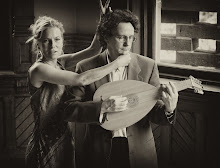Here's the program for the Rosary concert tonight at 100 St. Joseph St. Toronto. Map on how to get there at bottom.
The Christianty and Culture program at St Michael's College in the University of Toronto
and
The Musicians In Ordinary for the Lutes and Voices
present
The Rosary Sonatas – The Glorious Mysteries
Fr. Madden Auditorium, Carr Hall
100 St. Joseph St.
St. Michael’s College
Oct. 11, 2013
Lecture by Rev. Lisa Wang at 7:30PM, Concert at 8PM
The Resurrection Heinrich Ignaz Franz Biber (1644-1704)
Domine in adjuvandum Maurizio Cazzati (c1620-77)
O Lord, make haste to help me. Glory be to the Father, and to the Son, and to the Holy Ghost: As it was in the beginning, is now and ever shall be, world without end, Amen.
(Text – Response from the beginning of each of the Hours )
 |
| Click on the photo to get a closer look at the crossed strings |
The Ascension Biber
Vocem jucunditatis Alessandro Grandi (c.1580-1630)
Declare it with the voice of joy, and make it known, alleluia.
The Lord hath delivered His people, alleluia.
Christ has ascended on high. He has led captivity captive. He has given gifts to mankind, alleluia.
(Text – Excerpt from the Introit for the Fifth Sunday after Easter)
Pentecost Biber
Veni sancte Spiritus Giovanni Pozzo (fl. 1610)
Come Holy Spirit, you who are with the Father and the Son, one God through the ages; kindle in the depths of our hearts the flames of love, enliven us that we, loving the Lord, may enjoy you forever. O sweetest Spirit, I ask that you remain with me and keep watch over me always, so that, in the mouths of those celebrating you in song, you may be praised forever.
(Text – Free, with phrases from Sequence and Alleluia for Pentecost and Credo)
The Assumption of the Virgin Biber
Prudentissima virgo Grandi
Virgin most wise, where are you going, Daughter of Sion, shining out as brightly as the dawn? You are most comely and merciful, beautiful as the moon, excellent as the sun, alleluia.
(Text – Magnificat Antiphon, First Vespers of the Assumption of the BVM)
The Coronation of the Virgin Biber
O Quam speciosa Grandi
O how beautiful have you become, O Mary, thou lovely, thou kindly, O Mary, sweet rose.
O Mary, sweet rose, pray for us to Jesus Christ our Saviour, that he may protect and free us. O Mary, sweet rose, thou lovely, thou kindly, thou beauteous, thou glorious mother. O Mary, sweet rose.
O Mary, sweet rose, pray for us to Jesus Christ, Son of God, to preserve us in God’s love, thou beautiful, decorous, chosen mother of God. O Mary, sweet rose. Alleluia
(Text – Free, after the Song of Solomon)
Program Notes by Christopher Verrette
Biber’s Rosary Sonatas were a product of a culture that believed in using all the senses and all available media to contemplate the divine. This included visual art, music (both in sound and notation), dances (with which his audience would have been physically familiar) and in this particular case, unorthodox tunings of the violin. Here are some concise thoughts on how these things work together to contemplate the Glorious Mysteries.
The tuning of the Resurrection sonata is arguably the most expressive in the set, because it requires the player to cross the middle strings of the violin creating a visual symbol on the instrument, while disorienting the player's right arm as much as his left hand. The opening makes extensive use of the echo, perhaps suggesting the empty burial cave. What follows is the only reference to actual sacred music in this cycle: a set of variations on the hymn Surrexit Christus Hodie, written in gigantic, antique-style note values in the Trinitarian meter of 3/1, a visually stunning notational choice. The violin is heard playing in parallel octaves, like congregational singing, which is facilitated by the unusual tuning. After a final statement of the hymn in three octaves, the sonata ends with an introspective coda.
The picture of the Ascension in the score shows only Jesus' feet disappearing upward, which is mirrored in fast rising scales in the music, but the composer is clearly showing us His arrival in heaven to trumpet music. The tuning of the violin in a C Major chord makes this possible using a maximum of open strings. Two dances follow, of which the second is especially significant: Biber uses the courante exactly three times in the cycle. Dance historian Wendy Hilton has characterised the courante as "the dance of kings", and here it affirmatively expresses the triumphant fulfillment of something hinted at in earlier mysteries, in moments of humility and humiliation.
The sheer wildness of the writing in the sonata for Pentecost may betray Biber's birth in Bohemia. He quoted genuine folk music in other works and may have called upon his experience of folk fiddlers to suggest the winds and tongues of fire. It uses a brilliant tuning allowing for swirling passages in thirds and sixths.
The Assumption of the Virgin is some of the most light-hearted music to be found in the cycle. The opening passagework ends somewhat abruptly on a high note, indicating the direction of her travel. Most of the piece is a playful set of variations on a ground bass, though the whole story is told in a nutshell at the end: the violin disappears in mid-phrase leaving the continuo players alone on earth to contemplate the empty tomb.
The Coronation of the Virgin uses the most relaxed tuning to be found, creating a warm, deep sound. More formal counterpoint is used than in the other sonatas, but dance gets the last word: a saraband with a particularly delicate – even feminine – variation.







No comments:
Post a Comment